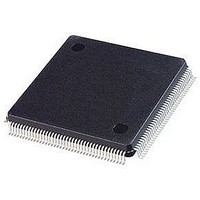EPM7160SQC160-10N Altera, EPM7160SQC160-10N Datasheet - Page 14

EPM7160SQC160-10N
Manufacturer Part Number
EPM7160SQC160-10N
Description
IC PLD EEPROM 160 MACROCELL 10NS QFP-160
Manufacturer
Altera
Series
MAX 7000Sr
Datasheet
1.EPM7064STC44-10.pdf
(66 pages)
Specifications of EPM7160SQC160-10N
Cpld Type
EEPROM
No. Of Macrocells
160
No. Of I/o's
104
Propagation Delay
10ns
Global Clock Setup Time
3.4ns
Frequency
149.3MHz
Supply Voltage Range
4.75V To 5.25V
Family Name
MAX 7000S
Memory Type
EEPROM
# Macrocells
160
Number Of Usable Gates
3200
Frequency (max)
125MHz
Propagation Delay Time
10ns
Number Of Logic Blocks/elements
10
# I/os (max)
104
Operating Supply Voltage (typ)
5V
In System Programmable
Yes
Operating Supply Voltage (min)
4.75V
Operating Supply Voltage (max)
5.25V
Operating Temp Range
0C to 70C
Operating Temperature Classification
Commercial
Mounting
Surface Mount
Pin Count
160
Package Type
PQFP
Lead Free Status / RoHS Status
Lead free / RoHS Compliant
Lead Free Status / RoHS Status
Lead free / RoHS Compliant
Available stocks
Company
Part Number
Manufacturer
Quantity
Price
MAX 7000 Programmable Logic Device Family Data Sheet
14
Programmable Interconnect Array
Logic is routed between LABs via the programmable interconnect array
(PIA). This global bus is a programmable path that connects any signal
source to any destination on the device. All MAX 7000 dedicated inputs,
I/O pins, and macrocell outputs feed the PIA, which makes the signals
available throughout the entire device. Only the signals required by each
LAB are actually routed from the PIA into the LAB.
the PIA signals are routed into the LAB. An EEPROM cell controls one
input to a 2-input AND gate, which selects a PIA signal to drive into the
LAB.
Figure 7. PIA Routing
While the routing delays of channel-based routing schemes in masked or
FPGAs are cumulative, variable, and path-dependent, the MAX 7000 PIA
has a fixed delay. The PIA thus eliminates skew between signals and
makes timing performance easy to predict.
I/O Control Blocks
The I/O control block allows each I/O pin to be individually configured
for input, output, or bidirectional operation. All I/O pins have a tri-state
buffer that is individually controlled by one of the global output enable
signals or directly connected to ground or V
control block for the MAX 7000 family. The I/O control block of EPM7032,
EPM7064, and EPM7096 devices has two global output enable signals that
are driven by two dedicated active-low output enable pins (OE1 and OE2).
The I/O control block of MAX 7000E and MAX 7000S devices has six
global output enable signals that are driven by the true or complement of
two output enable signals, a subset of the I/O pins, or a subset of the I/O
macrocells.
PIA Signals
CC
.
Figure 8
Figure 7
Altera Corporation
shows the I/O
shows how
To LAB














